Case Study Analysis: Crohn's Disease, Symptoms and Treatment Options
VerifiedAdded on 2022/08/23
|7
|1742
|22
Case Study
AI Summary
This case study examines the case of Jordan James, a 25-year-old male admitted to the hospital with symptoms indicative of Crohn's disease. The assignment delves into the structural and functional changes associated with Crohn's disease, including its impact on the gastrointestinal system, the underlying causes of inflammation, and the morphological changes it induces, such as ulcerations and strictures. The study further explores the clinical manifestations of the disease, including abdominal cramps, diarrhea, and weight loss, and the rationale behind the use of Hartmann's solution in managing fluid and electrolyte imbalances. Additionally, the assignment provides an overview of the pain pathway and the role of morphine in altering pain perception. The case study integrates relevant medical literature to support the analysis and provides a comprehensive understanding of the disease and its management.
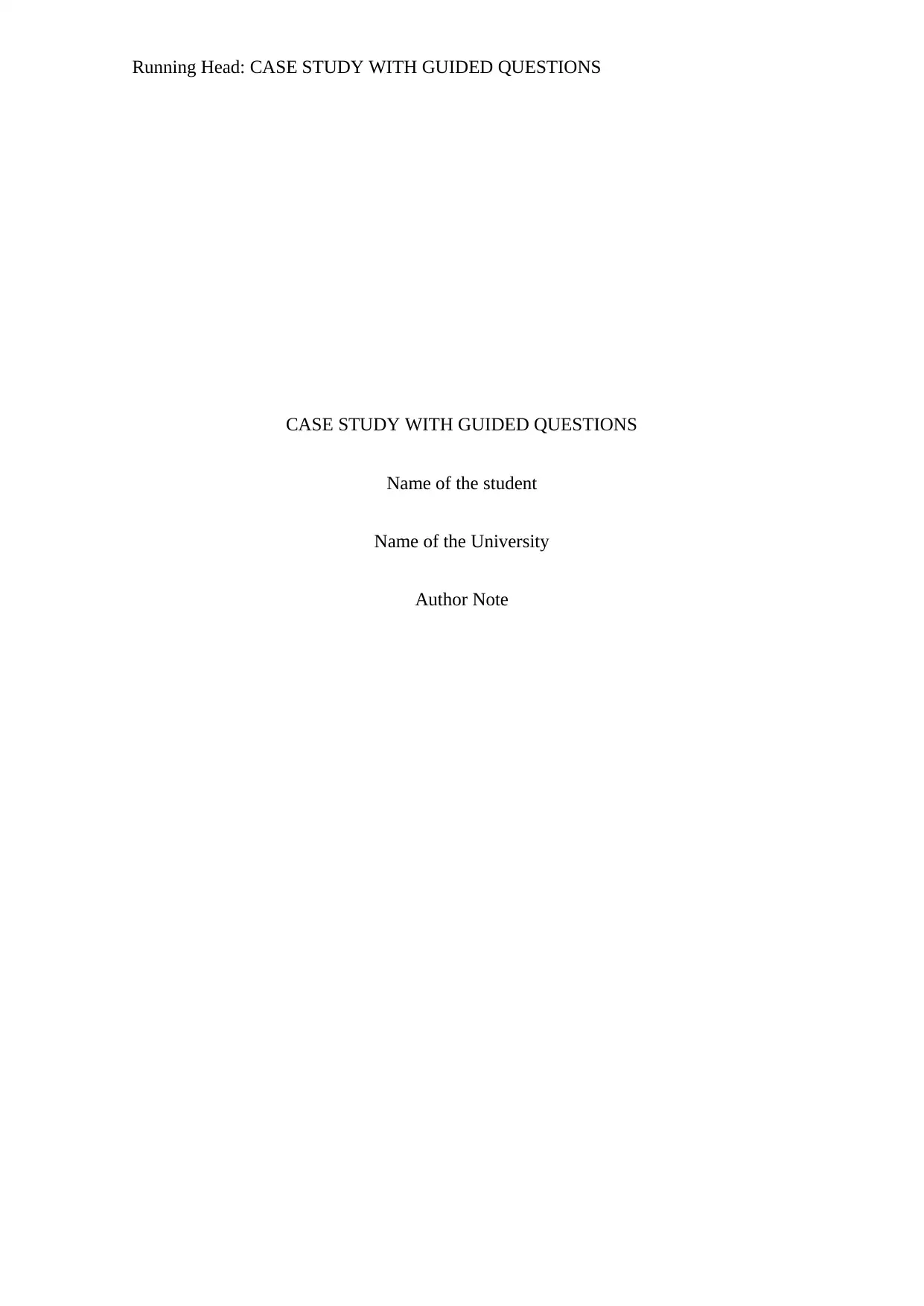
Running Head: CASE STUDY WITH GUIDED QUESTIONS
CASE STUDY WITH GUIDED QUESTIONS
Name of the student
Name of the University
Author Note
CASE STUDY WITH GUIDED QUESTIONS
Name of the student
Name of the University
Author Note
Paraphrase This Document
Need a fresh take? Get an instant paraphrase of this document with our AI Paraphraser
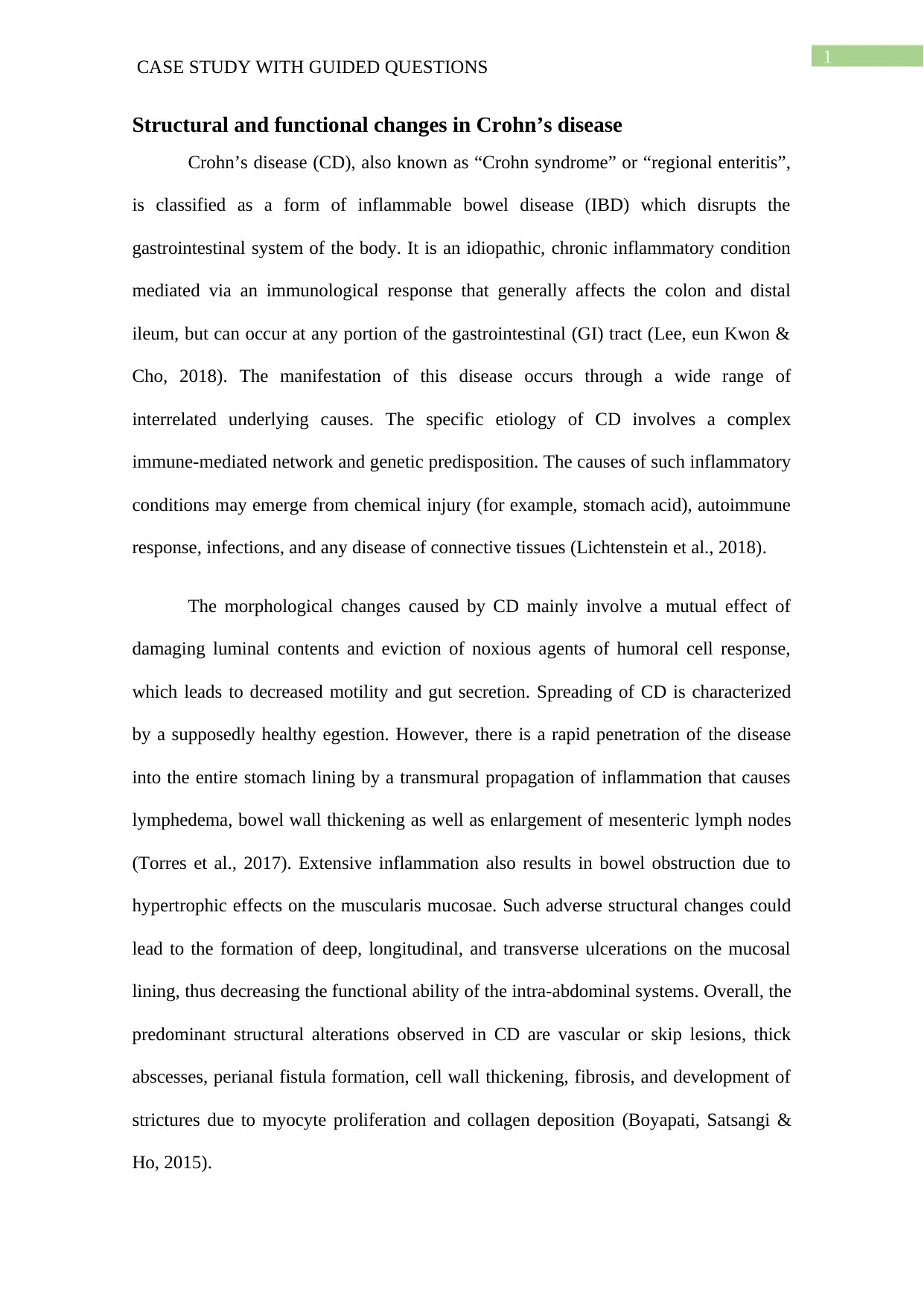
1
CASE STUDY WITH GUIDED QUESTIONS
Structural and functional changes in Crohn’s disease
Crohn’s disease (CD), also known as “Crohn syndrome” or “regional enteritis”,
is classified as a form of inflammable bowel disease (IBD) which disrupts the
gastrointestinal system of the body. It is an idiopathic, chronic inflammatory condition
mediated via an immunological response that generally affects the colon and distal
ileum, but can occur at any portion of the gastrointestinal (GI) tract (Lee, eun Kwon &
Cho, 2018). The manifestation of this disease occurs through a wide range of
interrelated underlying causes. The specific etiology of CD involves a complex
immune-mediated network and genetic predisposition. The causes of such inflammatory
conditions may emerge from chemical injury (for example, stomach acid), autoimmune
response, infections, and any disease of connective tissues (Lichtenstein et al., 2018).
The morphological changes caused by CD mainly involve a mutual effect of
damaging luminal contents and eviction of noxious agents of humoral cell response,
which leads to decreased motility and gut secretion. Spreading of CD is characterized
by a supposedly healthy egestion. However, there is a rapid penetration of the disease
into the entire stomach lining by a transmural propagation of inflammation that causes
lymphedema, bowel wall thickening as well as enlargement of mesenteric lymph nodes
(Torres et al., 2017). Extensive inflammation also results in bowel obstruction due to
hypertrophic effects on the muscularis mucosae. Such adverse structural changes could
lead to the formation of deep, longitudinal, and transverse ulcerations on the mucosal
lining, thus decreasing the functional ability of the intra-abdominal systems. Overall, the
predominant structural alterations observed in CD are vascular or skip lesions, thick
abscesses, perianal fistula formation, cell wall thickening, fibrosis, and development of
strictures due to myocyte proliferation and collagen deposition (Boyapati, Satsangi &
Ho, 2015).
CASE STUDY WITH GUIDED QUESTIONS
Structural and functional changes in Crohn’s disease
Crohn’s disease (CD), also known as “Crohn syndrome” or “regional enteritis”,
is classified as a form of inflammable bowel disease (IBD) which disrupts the
gastrointestinal system of the body. It is an idiopathic, chronic inflammatory condition
mediated via an immunological response that generally affects the colon and distal
ileum, but can occur at any portion of the gastrointestinal (GI) tract (Lee, eun Kwon &
Cho, 2018). The manifestation of this disease occurs through a wide range of
interrelated underlying causes. The specific etiology of CD involves a complex
immune-mediated network and genetic predisposition. The causes of such inflammatory
conditions may emerge from chemical injury (for example, stomach acid), autoimmune
response, infections, and any disease of connective tissues (Lichtenstein et al., 2018).
The morphological changes caused by CD mainly involve a mutual effect of
damaging luminal contents and eviction of noxious agents of humoral cell response,
which leads to decreased motility and gut secretion. Spreading of CD is characterized
by a supposedly healthy egestion. However, there is a rapid penetration of the disease
into the entire stomach lining by a transmural propagation of inflammation that causes
lymphedema, bowel wall thickening as well as enlargement of mesenteric lymph nodes
(Torres et al., 2017). Extensive inflammation also results in bowel obstruction due to
hypertrophic effects on the muscularis mucosae. Such adverse structural changes could
lead to the formation of deep, longitudinal, and transverse ulcerations on the mucosal
lining, thus decreasing the functional ability of the intra-abdominal systems. Overall, the
predominant structural alterations observed in CD are vascular or skip lesions, thick
abscesses, perianal fistula formation, cell wall thickening, fibrosis, and development of
strictures due to myocyte proliferation and collagen deposition (Boyapati, Satsangi &
Ho, 2015).
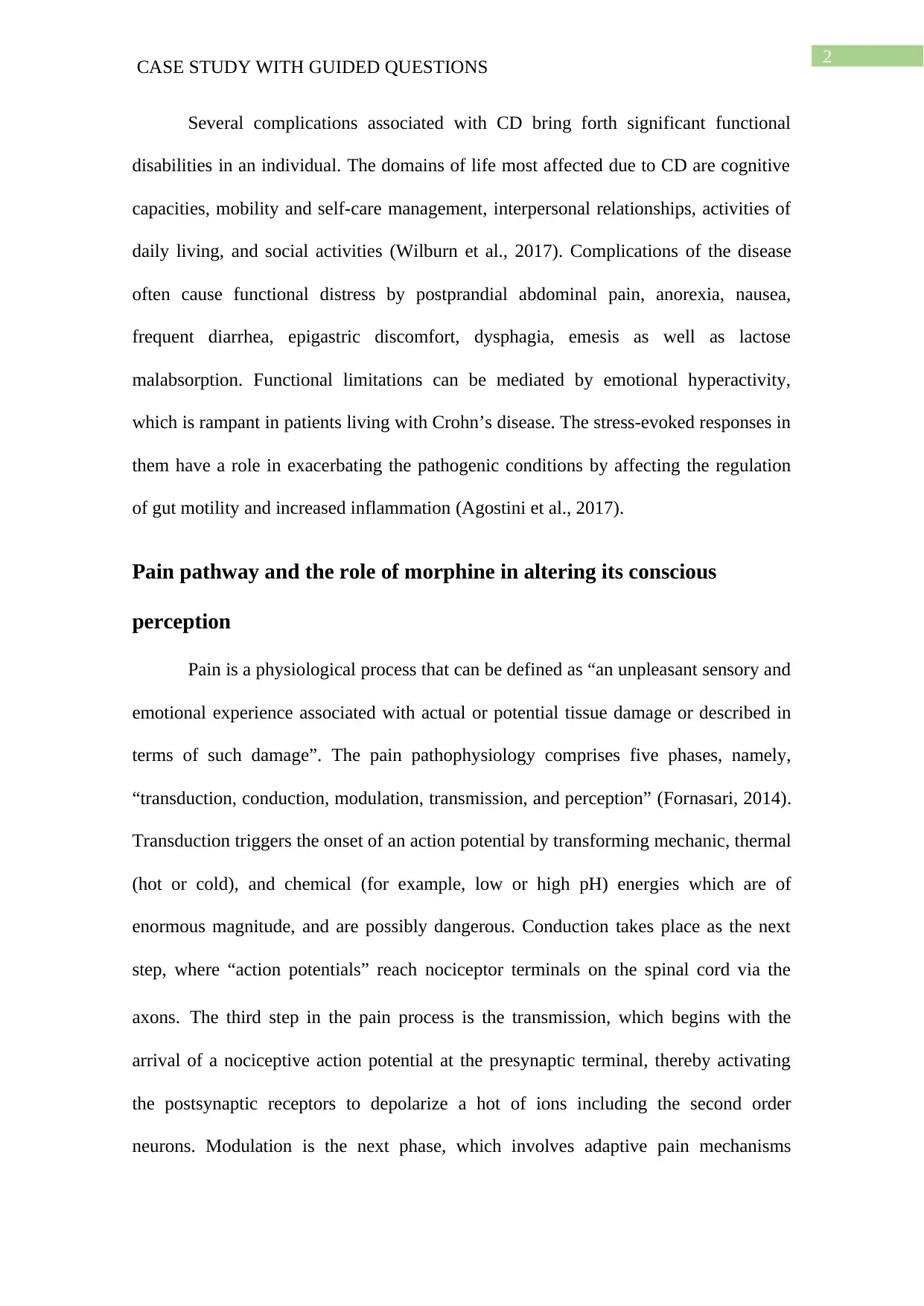
2
CASE STUDY WITH GUIDED QUESTIONS
Several complications associated with CD bring forth significant functional
disabilities in an individual. The domains of life most affected due to CD are cognitive
capacities, mobility and self-care management, interpersonal relationships, activities of
daily living, and social activities (Wilburn et al., 2017). Complications of the disease
often cause functional distress by postprandial abdominal pain, anorexia, nausea,
frequent diarrhea, epigastric discomfort, dysphagia, emesis as well as lactose
malabsorption. Functional limitations can be mediated by emotional hyperactivity,
which is rampant in patients living with Crohn’s disease. The stress-evoked responses in
them have a role in exacerbating the pathogenic conditions by affecting the regulation
of gut motility and increased inflammation (Agostini et al., 2017).
Pain pathway and the role of morphine in altering its conscious
perception
Pain is a physiological process that can be defined as “an unpleasant sensory and
emotional experience associated with actual or potential tissue damage or described in
terms of such damage”. The pain pathophysiology comprises five phases, namely,
“transduction, conduction, modulation, transmission, and perception” (Fornasari, 2014).
Transduction triggers the onset of an action potential by transforming mechanic, thermal
(hot or cold), and chemical (for example, low or high pH) energies which are of
enormous magnitude, and are possibly dangerous. Conduction takes place as the next
step, where “action potentials” reach nociceptor terminals on the spinal cord via the
axons. The third step in the pain process is the transmission, which begins with the
arrival of a nociceptive action potential at the presynaptic terminal, thereby activating
the postsynaptic receptors to depolarize a hot of ions including the second order
neurons. Modulation is the next phase, which involves adaptive pain mechanisms
CASE STUDY WITH GUIDED QUESTIONS
Several complications associated with CD bring forth significant functional
disabilities in an individual. The domains of life most affected due to CD are cognitive
capacities, mobility and self-care management, interpersonal relationships, activities of
daily living, and social activities (Wilburn et al., 2017). Complications of the disease
often cause functional distress by postprandial abdominal pain, anorexia, nausea,
frequent diarrhea, epigastric discomfort, dysphagia, emesis as well as lactose
malabsorption. Functional limitations can be mediated by emotional hyperactivity,
which is rampant in patients living with Crohn’s disease. The stress-evoked responses in
them have a role in exacerbating the pathogenic conditions by affecting the regulation
of gut motility and increased inflammation (Agostini et al., 2017).
Pain pathway and the role of morphine in altering its conscious
perception
Pain is a physiological process that can be defined as “an unpleasant sensory and
emotional experience associated with actual or potential tissue damage or described in
terms of such damage”. The pain pathophysiology comprises five phases, namely,
“transduction, conduction, modulation, transmission, and perception” (Fornasari, 2014).
Transduction triggers the onset of an action potential by transforming mechanic, thermal
(hot or cold), and chemical (for example, low or high pH) energies which are of
enormous magnitude, and are possibly dangerous. Conduction takes place as the next
step, where “action potentials” reach nociceptor terminals on the spinal cord via the
axons. The third step in the pain process is the transmission, which begins with the
arrival of a nociceptive action potential at the presynaptic terminal, thereby activating
the postsynaptic receptors to depolarize a hot of ions including the second order
neurons. Modulation is the next phase, which involves adaptive pain mechanisms
⊘ This is a preview!⊘
Do you want full access?
Subscribe today to unlock all pages.

Trusted by 1+ million students worldwide
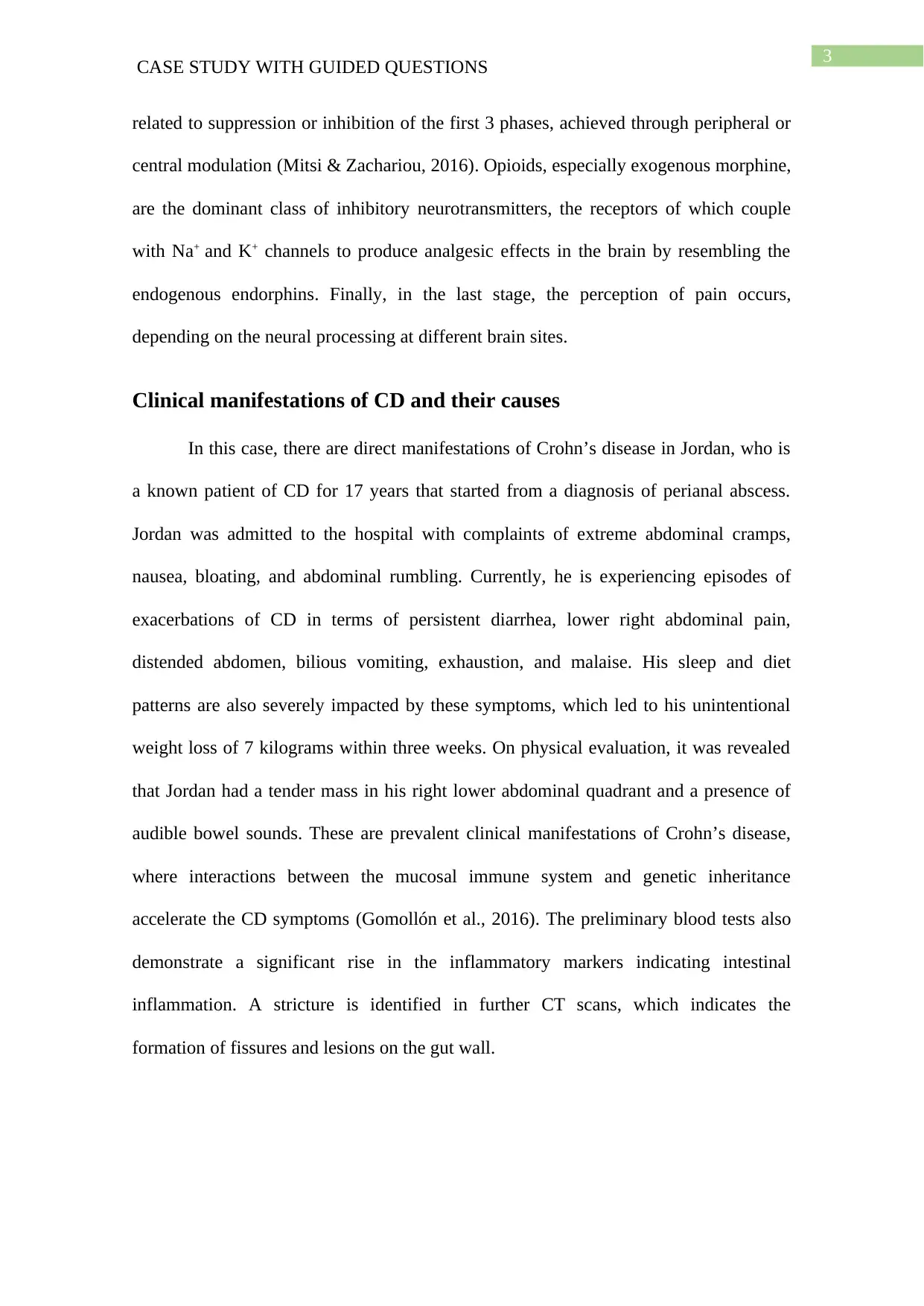
3
CASE STUDY WITH GUIDED QUESTIONS
related to suppression or inhibition of the first 3 phases, achieved through peripheral or
central modulation (Mitsi & Zachariou, 2016). Opioids, especially exogenous morphine,
are the dominant class of inhibitory neurotransmitters, the receptors of which couple
with Na+ and K+ channels to produce analgesic effects in the brain by resembling the
endogenous endorphins. Finally, in the last stage, the perception of pain occurs,
depending on the neural processing at different brain sites.
Clinical manifestations of CD and their causes
In this case, there are direct manifestations of Crohn’s disease in Jordan, who is
a known patient of CD for 17 years that started from a diagnosis of perianal abscess.
Jordan was admitted to the hospital with complaints of extreme abdominal cramps,
nausea, bloating, and abdominal rumbling. Currently, he is experiencing episodes of
exacerbations of CD in terms of persistent diarrhea, lower right abdominal pain,
distended abdomen, bilious vomiting, exhaustion, and malaise. His sleep and diet
patterns are also severely impacted by these symptoms, which led to his unintentional
weight loss of 7 kilograms within three weeks. On physical evaluation, it was revealed
that Jordan had a tender mass in his right lower abdominal quadrant and a presence of
audible bowel sounds. These are prevalent clinical manifestations of Crohn’s disease,
where interactions between the mucosal immune system and genetic inheritance
accelerate the CD symptoms (Gomollón et al., 2016). The preliminary blood tests also
demonstrate a significant rise in the inflammatory markers indicating intestinal
inflammation. A stricture is identified in further CT scans, which indicates the
formation of fissures and lesions on the gut wall.
CASE STUDY WITH GUIDED QUESTIONS
related to suppression or inhibition of the first 3 phases, achieved through peripheral or
central modulation (Mitsi & Zachariou, 2016). Opioids, especially exogenous morphine,
are the dominant class of inhibitory neurotransmitters, the receptors of which couple
with Na+ and K+ channels to produce analgesic effects in the brain by resembling the
endogenous endorphins. Finally, in the last stage, the perception of pain occurs,
depending on the neural processing at different brain sites.
Clinical manifestations of CD and their causes
In this case, there are direct manifestations of Crohn’s disease in Jordan, who is
a known patient of CD for 17 years that started from a diagnosis of perianal abscess.
Jordan was admitted to the hospital with complaints of extreme abdominal cramps,
nausea, bloating, and abdominal rumbling. Currently, he is experiencing episodes of
exacerbations of CD in terms of persistent diarrhea, lower right abdominal pain,
distended abdomen, bilious vomiting, exhaustion, and malaise. His sleep and diet
patterns are also severely impacted by these symptoms, which led to his unintentional
weight loss of 7 kilograms within three weeks. On physical evaluation, it was revealed
that Jordan had a tender mass in his right lower abdominal quadrant and a presence of
audible bowel sounds. These are prevalent clinical manifestations of Crohn’s disease,
where interactions between the mucosal immune system and genetic inheritance
accelerate the CD symptoms (Gomollón et al., 2016). The preliminary blood tests also
demonstrate a significant rise in the inflammatory markers indicating intestinal
inflammation. A stricture is identified in further CT scans, which indicates the
formation of fissures and lesions on the gut wall.
Paraphrase This Document
Need a fresh take? Get an instant paraphrase of this document with our AI Paraphraser
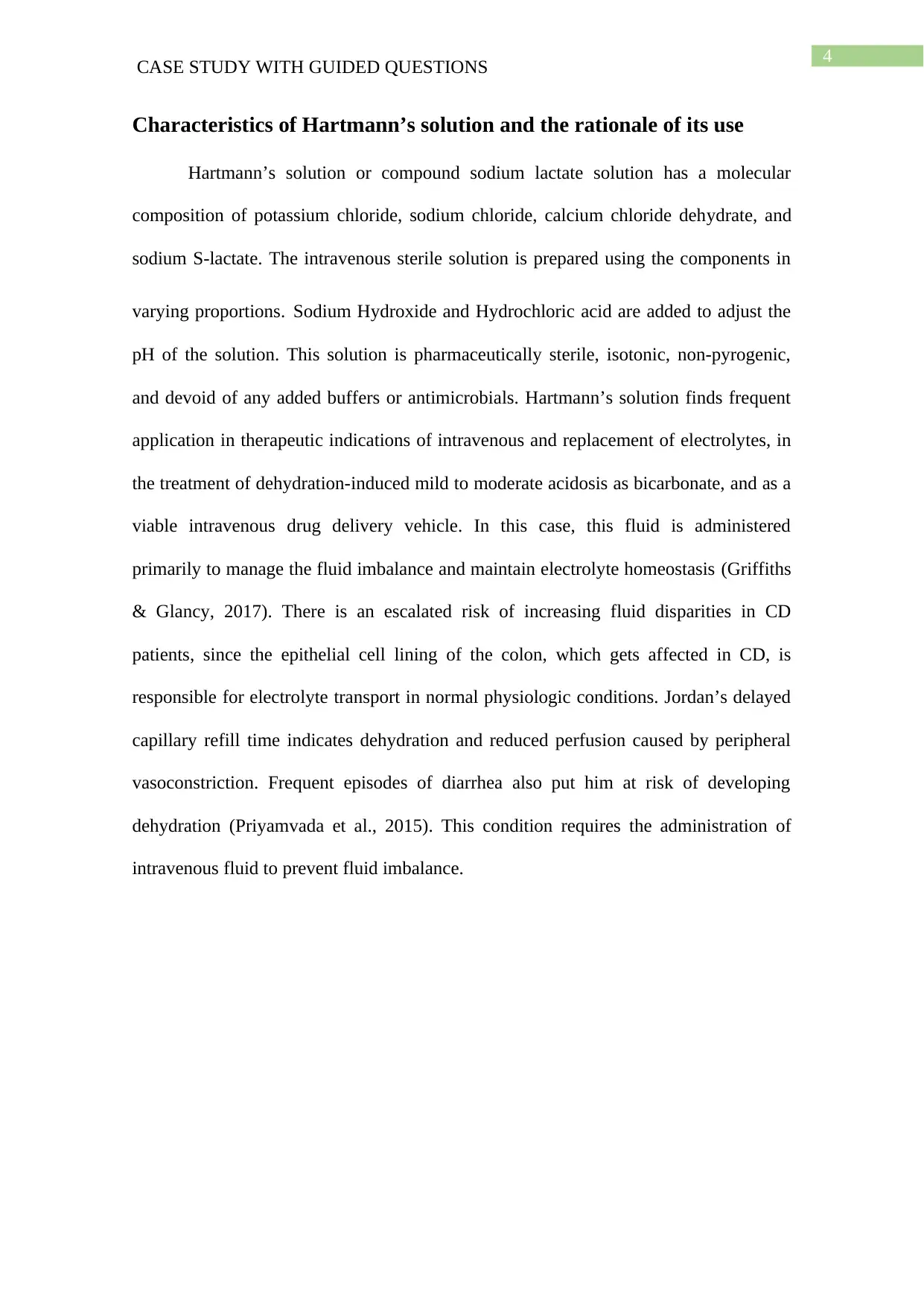
4
CASE STUDY WITH GUIDED QUESTIONS
Characteristics of Hartmann’s solution and the rationale of its use
Hartmann’s solution or compound sodium lactate solution has a molecular
composition of potassium chloride, sodium chloride, calcium chloride dehydrate, and
sodium S-lactate. The intravenous sterile solution is prepared using the components in
varying proportions. Sodium Hydroxide and Hydrochloric acid are added to adjust the
pH of the solution. This solution is pharmaceutically sterile, isotonic, non-pyrogenic,
and devoid of any added buffers or antimicrobials. Hartmann’s solution finds frequent
application in therapeutic indications of intravenous and replacement of electrolytes, in
the treatment of dehydration-induced mild to moderate acidosis as bicarbonate, and as a
viable intravenous drug delivery vehicle. In this case, this fluid is administered
primarily to manage the fluid imbalance and maintain electrolyte homeostasis (Griffiths
& Glancy, 2017). There is an escalated risk of increasing fluid disparities in CD
patients, since the epithelial cell lining of the colon, which gets affected in CD, is
responsible for electrolyte transport in normal physiologic conditions. Jordan’s delayed
capillary refill time indicates dehydration and reduced perfusion caused by peripheral
vasoconstriction. Frequent episodes of diarrhea also put him at risk of developing
dehydration (Priyamvada et al., 2015). This condition requires the administration of
intravenous fluid to prevent fluid imbalance.
CASE STUDY WITH GUIDED QUESTIONS
Characteristics of Hartmann’s solution and the rationale of its use
Hartmann’s solution or compound sodium lactate solution has a molecular
composition of potassium chloride, sodium chloride, calcium chloride dehydrate, and
sodium S-lactate. The intravenous sterile solution is prepared using the components in
varying proportions. Sodium Hydroxide and Hydrochloric acid are added to adjust the
pH of the solution. This solution is pharmaceutically sterile, isotonic, non-pyrogenic,
and devoid of any added buffers or antimicrobials. Hartmann’s solution finds frequent
application in therapeutic indications of intravenous and replacement of electrolytes, in
the treatment of dehydration-induced mild to moderate acidosis as bicarbonate, and as a
viable intravenous drug delivery vehicle. In this case, this fluid is administered
primarily to manage the fluid imbalance and maintain electrolyte homeostasis (Griffiths
& Glancy, 2017). There is an escalated risk of increasing fluid disparities in CD
patients, since the epithelial cell lining of the colon, which gets affected in CD, is
responsible for electrolyte transport in normal physiologic conditions. Jordan’s delayed
capillary refill time indicates dehydration and reduced perfusion caused by peripheral
vasoconstriction. Frequent episodes of diarrhea also put him at risk of developing
dehydration (Priyamvada et al., 2015). This condition requires the administration of
intravenous fluid to prevent fluid imbalance.
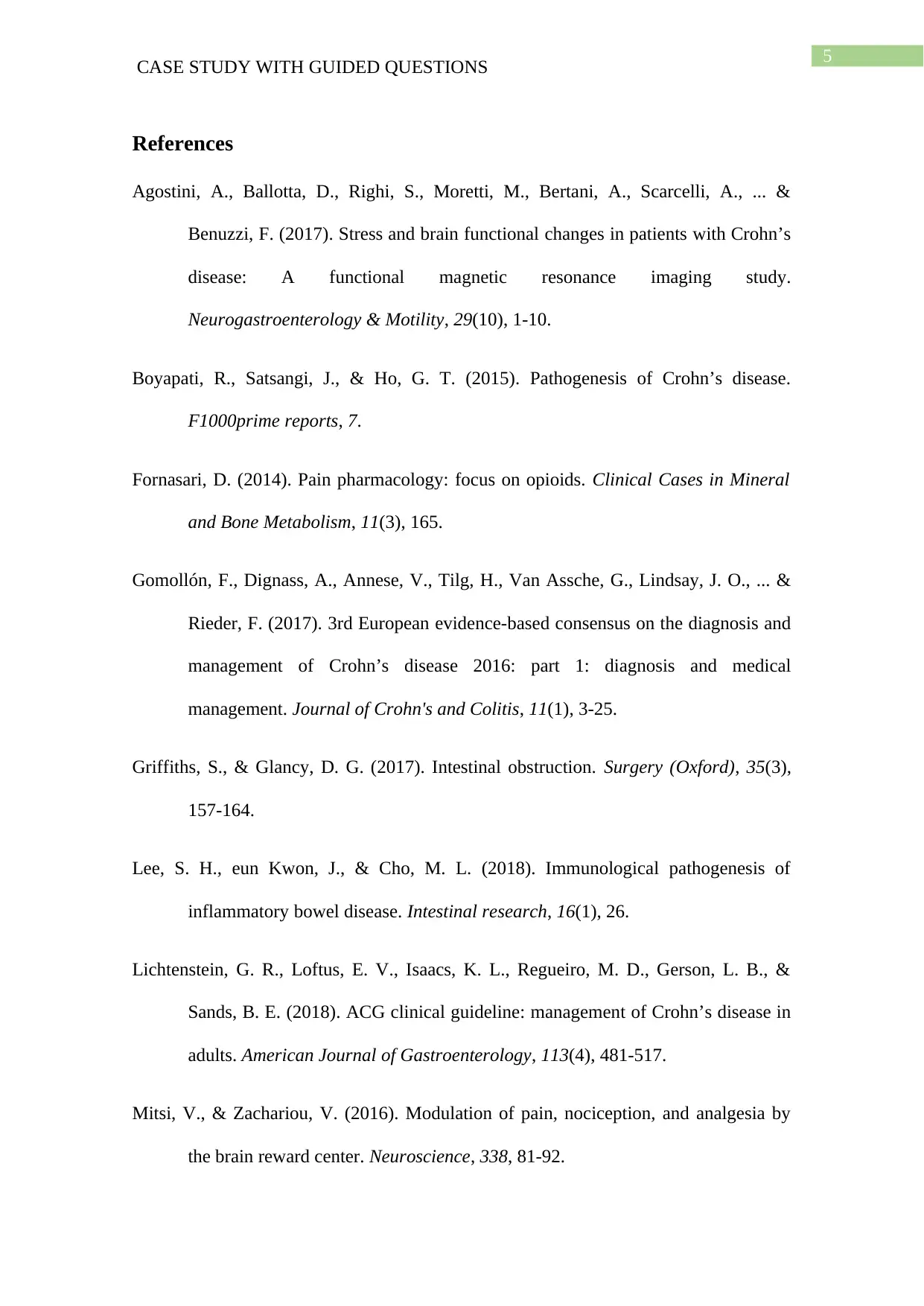
5
CASE STUDY WITH GUIDED QUESTIONS
References
Agostini, A., Ballotta, D., Righi, S., Moretti, M., Bertani, A., Scarcelli, A., ... &
Benuzzi, F. (2017). Stress and brain functional changes in patients with Crohn’s
disease: A functional magnetic resonance imaging study.
Neurogastroenterology & Motility, 29(10), 1-10.
Boyapati, R., Satsangi, J., & Ho, G. T. (2015). Pathogenesis of Crohn’s disease.
F1000prime reports, 7.
Fornasari, D. (2014). Pain pharmacology: focus on opioids. Clinical Cases in Mineral
and Bone Metabolism, 11(3), 165.
Gomollón, F., Dignass, A., Annese, V., Tilg, H., Van Assche, G., Lindsay, J. O., ... &
Rieder, F. (2017). 3rd European evidence-based consensus on the diagnosis and
management of Crohn’s disease 2016: part 1: diagnosis and medical
management. Journal of Crohn's and Colitis, 11(1), 3-25.
Griffiths, S., & Glancy, D. G. (2017). Intestinal obstruction. Surgery (Oxford), 35(3),
157-164.
Lee, S. H., eun Kwon, J., & Cho, M. L. (2018). Immunological pathogenesis of
inflammatory bowel disease. Intestinal research, 16(1), 26.
Lichtenstein, G. R., Loftus, E. V., Isaacs, K. L., Regueiro, M. D., Gerson, L. B., &
Sands, B. E. (2018). ACG clinical guideline: management of Crohn’s disease in
adults. American Journal of Gastroenterology, 113(4), 481-517.
Mitsi, V., & Zachariou, V. (2016). Modulation of pain, nociception, and analgesia by
the brain reward center. Neuroscience, 338, 81-92.
CASE STUDY WITH GUIDED QUESTIONS
References
Agostini, A., Ballotta, D., Righi, S., Moretti, M., Bertani, A., Scarcelli, A., ... &
Benuzzi, F. (2017). Stress and brain functional changes in patients with Crohn’s
disease: A functional magnetic resonance imaging study.
Neurogastroenterology & Motility, 29(10), 1-10.
Boyapati, R., Satsangi, J., & Ho, G. T. (2015). Pathogenesis of Crohn’s disease.
F1000prime reports, 7.
Fornasari, D. (2014). Pain pharmacology: focus on opioids. Clinical Cases in Mineral
and Bone Metabolism, 11(3), 165.
Gomollón, F., Dignass, A., Annese, V., Tilg, H., Van Assche, G., Lindsay, J. O., ... &
Rieder, F. (2017). 3rd European evidence-based consensus on the diagnosis and
management of Crohn’s disease 2016: part 1: diagnosis and medical
management. Journal of Crohn's and Colitis, 11(1), 3-25.
Griffiths, S., & Glancy, D. G. (2017). Intestinal obstruction. Surgery (Oxford), 35(3),
157-164.
Lee, S. H., eun Kwon, J., & Cho, M. L. (2018). Immunological pathogenesis of
inflammatory bowel disease. Intestinal research, 16(1), 26.
Lichtenstein, G. R., Loftus, E. V., Isaacs, K. L., Regueiro, M. D., Gerson, L. B., &
Sands, B. E. (2018). ACG clinical guideline: management of Crohn’s disease in
adults. American Journal of Gastroenterology, 113(4), 481-517.
Mitsi, V., & Zachariou, V. (2016). Modulation of pain, nociception, and analgesia by
the brain reward center. Neuroscience, 338, 81-92.
⊘ This is a preview!⊘
Do you want full access?
Subscribe today to unlock all pages.

Trusted by 1+ million students worldwide
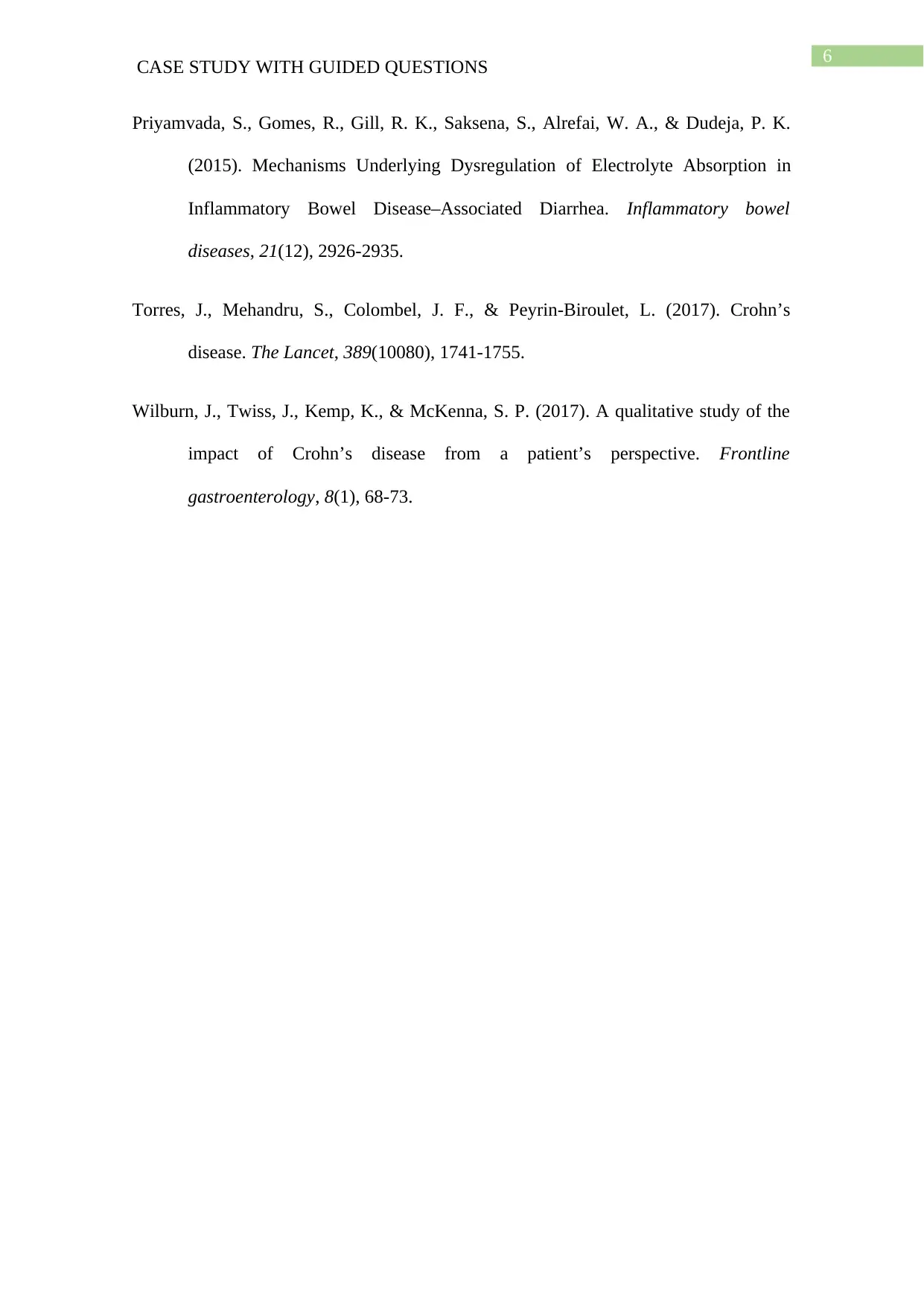
6
CASE STUDY WITH GUIDED QUESTIONS
Priyamvada, S., Gomes, R., Gill, R. K., Saksena, S., Alrefai, W. A., & Dudeja, P. K.
(2015). Mechanisms Underlying Dysregulation of Electrolyte Absorption in
Inflammatory Bowel Disease–Associated Diarrhea. Inflammatory bowel
diseases, 21(12), 2926-2935.
Torres, J., Mehandru, S., Colombel, J. F., & Peyrin-Biroulet, L. (2017). Crohn’s
disease. The Lancet, 389(10080), 1741-1755.
Wilburn, J., Twiss, J., Kemp, K., & McKenna, S. P. (2017). A qualitative study of the
impact of Crohn’s disease from a patient’s perspective. Frontline
gastroenterology, 8(1), 68-73.
CASE STUDY WITH GUIDED QUESTIONS
Priyamvada, S., Gomes, R., Gill, R. K., Saksena, S., Alrefai, W. A., & Dudeja, P. K.
(2015). Mechanisms Underlying Dysregulation of Electrolyte Absorption in
Inflammatory Bowel Disease–Associated Diarrhea. Inflammatory bowel
diseases, 21(12), 2926-2935.
Torres, J., Mehandru, S., Colombel, J. F., & Peyrin-Biroulet, L. (2017). Crohn’s
disease. The Lancet, 389(10080), 1741-1755.
Wilburn, J., Twiss, J., Kemp, K., & McKenna, S. P. (2017). A qualitative study of the
impact of Crohn’s disease from a patient’s perspective. Frontline
gastroenterology, 8(1), 68-73.
1 out of 7
Related Documents
Your All-in-One AI-Powered Toolkit for Academic Success.
+13062052269
info@desklib.com
Available 24*7 on WhatsApp / Email
![[object Object]](/_next/static/media/star-bottom.7253800d.svg)
Unlock your academic potential
Copyright © 2020–2025 A2Z Services. All Rights Reserved. Developed and managed by ZUCOL.





